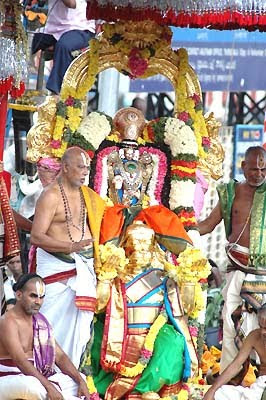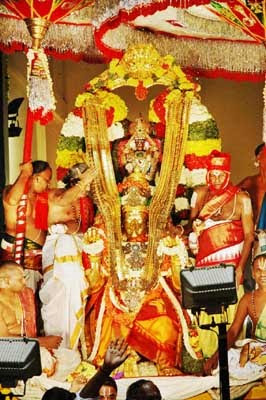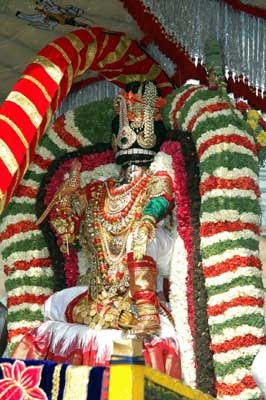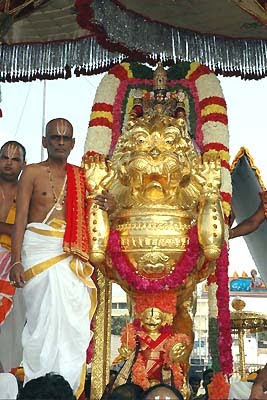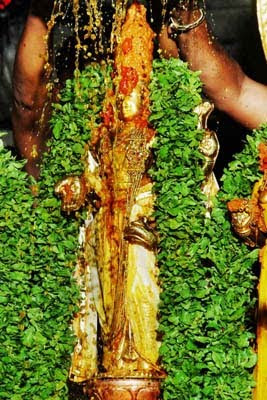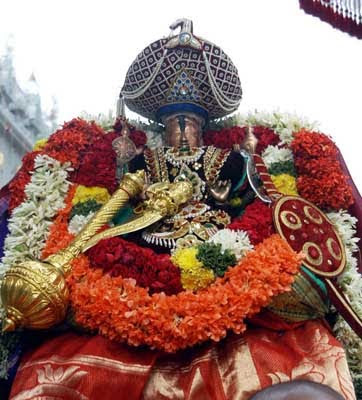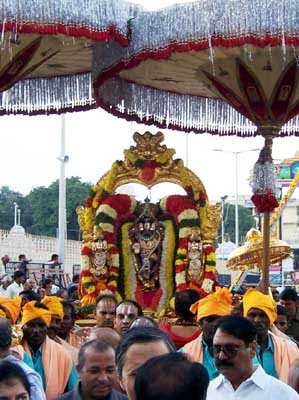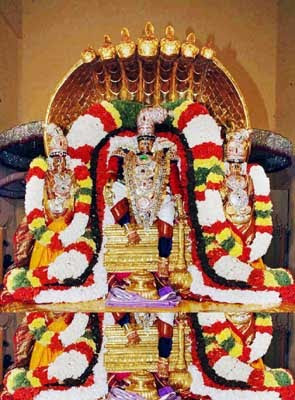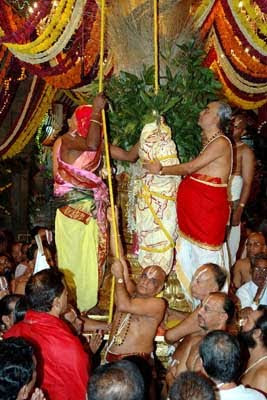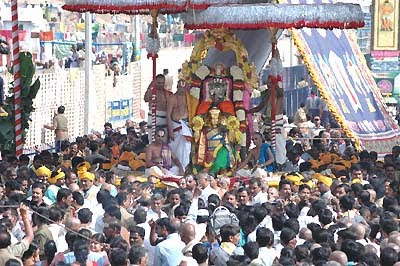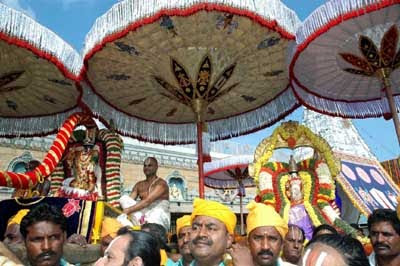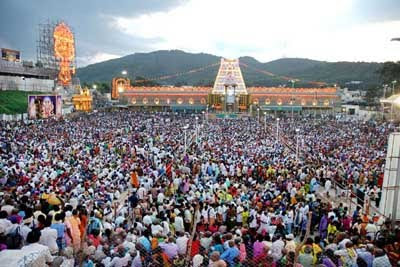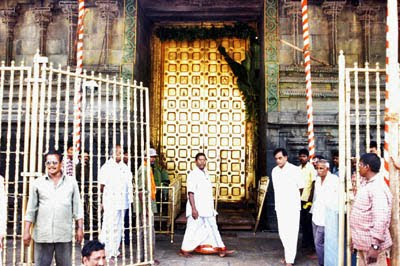Avoidable and recommendable works during Surya Grahan and Chandra Grahan:
* It is advisable to avoid performing any important work or deal.
* After Grahan, many Hindus perform ritual bath. Take meal only after the ritual bath. Taking a holy dip in rivers or lakes is highly auspicious.
* Many Hindus observe fasting on the day of Surya or Chandra Grahanam.
* Avoid outside food during grahanam and as well as the whole day.
* Perform ritual bath, Puja, Japam, havan and all other rituals only after Grahan Moksh Kaal (the time when grahan is released).
* Avoid eating at the time of Grahanam.
* Avoid eating the food which is cooked before Grahan. Take the food which is cooked after Grahan. People can eat the food that is prevented from ‘Soothak (Ashouch). To prevent food from Soothak, just spill some til seeds or keep grass blades (Durva grass) on the food before grahan.
* Put Tulsi leaf/ dharbha grass on stored food-items including curd, jams, pickles, etc.
* During Surya Grahan, reciting Surya Stotras such as Aditya Hridayam; Maha Mritunjaya Mantram and Vishnu Stotras is highly auspicious.
For Chandra Grahanam (Lunar Eclipse) there is a slokam to be recited at least 28 times (or 108 times) at the beginning of Eclipse. This is for those who are born under a particular birth star (Nakshatra) in which the Eclipse occurs. This is the Grahana Shanthi parihara slokam, given for each Grahana or eclipse as below, in Sanskrit and the phonetic English versus:

This slokam is to be recited as specified at the beginning of Eclipse and after the Eclipse is over, to take bath. There is also a practice to offer some Dakshina with Wheat for Surya Grahanam and Rice for Chandra Grahanam as shanthi paraharam offering to any Brahmin after the Grahanam. Only in those who are born in specific Stars (Nakshatra) need to perform this shanti pariharam.
This lunar eclipse will yield following effect to those living in foreign countries:
This eclipse is not good for the natives of Aries, Gemini, Scorpio and Pisces. So they should avoid seeing this lunar eclipse and perform religious rituals.
Nonetheless, other signs will get either good impact or mixed results of this lunar eclipse. Therefore, they need not worry about it.
What Precaution Pregnant Women Should Take During Chandra Grahan or Lunar Eclipse?
Lunar eclipse is caused by the entering of the Moon into the earth-shadow. When the Earth moves between the Sun and the Moon, the shadow of the Earth covers the Moon producing a Lunar Eclipse. The light of the Moon is darkened temporarily. It occurs on a full moon day when the Moon is directly opposite to the Sun.
Lunar Eclipse in Britain in December 2010 – Chandra Grahan in United Kingdom.
A Total Lunar Eclipse, Chandra Grahan, will take place in Britain on December 21, 2010. In United Kingdom, the time of the Lunar Eclipse is early morning. The total lunar eclipse Begins at 06:33 AM on December 21, 2010 in England. The time is same for all the places in Britain – Birmingham, Brighton, Bristol, Coventry, Leeds, Leicester, Liverpool, London, Manchester, Middlesbrough, Newcastle, Nottingham, Portsmouth, Sheffield, Belfast, Cardiff, Edinburgh and Glasgow.
The lunar eclipse on December 21, 2010 is at Moonrise in Britain.
The Total Lunar Eclipse in Britain is from 07:41 AM to 08:53 AM (Local Time) – the visibility ends soon as sun rises. Mid-eclipse is at 08:17 AM. The eclipse ends in United Kingdom at 10:01 AM.
If you are a Hindu who keeps fast during eclipse, then you have to follow it if you are living in Britain.
Time of Lunar Eclipse on December 2010 in various parts in Britain
Eclipse Begins at 06:33 AM on December 21, 2010 (Local Time)
Total Lunar Eclipse from 07:41 hrs to 08:53 hrs
Mid Eclipse during the eclipse is at 08:17 hrs (Visible)
Eclipse Ends at 10:01 hrs
NASA has given the same time for all places in England.
Astronomers say the Moon could turn a pink or blood red hue during the eclipse.

The Moon is normally illuminated by the Sun. During a total lunar eclipse, the full Moon passes through the shadow created by the Earth blocking the Sun's light.
Some indirect sunlight will still manage to pierce through and give the Moon a ghostly colour.
The massive formation like the sun and moon and their faction has enormous effect on the human beings lives.
Viewing the Moon eclipse or lunar eclipse by naked eye can decrease the eye sight potency of human.
The full lunar eclipse or moon eclipse has physically powerful result on the water in our oceans and may create gigantic tidal waves which can formed in the water as a effect of gravitational power heave of the moon.
After a wait of 372 years, sky gazers are in for a special celestial treat as winter solstice coincides with total lunar eclipse on Tuesday.
The last time the two astronomical events coincided was on December 21, 1638, Geoff Chester of U.S. Naval Observatory said.
Also, Tuesday (December 21) is the shortest day of the year as people living on the northern side of the equator will celebrate winter solstice.
“It is a day when the Earth’s axis tilts the farthest from the sun and is called winter solstice, a term derived from Latin words ‘sol’ (sun) and ‘sistere’ (to stand still),” Science Popularisation Association of Communicators and Educators (SPACE) president C.B. Devgun said.
A solstice is an astronomical event which happens twice each year, when the tilt of the Earth’s axis is most inclined toward or away from the sun, causing the sun’s apparent position in the sky to reach its northernmost or southernmost extreme, he said.
On the day of winter solstice, North Pole points directly away from the sun and South Pole points directly towards the Sun, he said, adding the sun shines at lowest heights in northern skies and at maximum heights in southern skies.
This results in the shortest day in the Northern Hemisphere, but at the same time it is the longest day in Southern Hemisphere.
The winter solstice will be at 5.08 a.m. on December 22.

